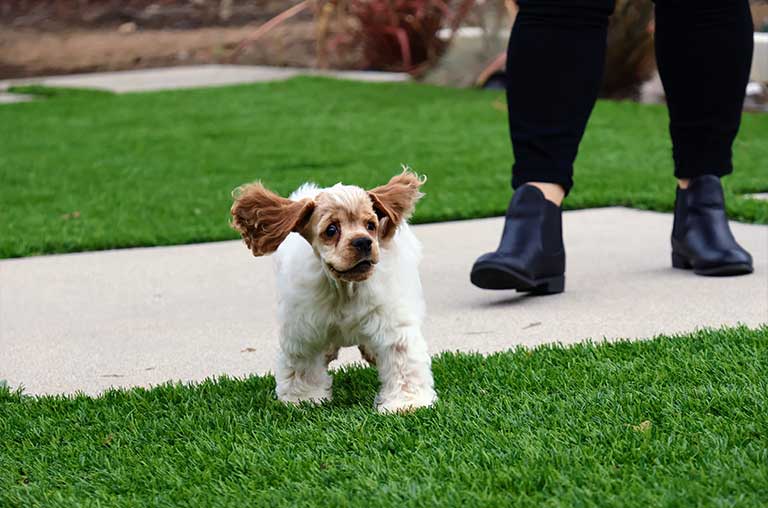The key difference between working and show cocker spaniels is that the former is leaner and more energetic than the latter. If you’re planning to welcome a cocker spaniel as your family’s canine friend, certainly this difference is not enough to help you decide.
It doesn’t matter whether you’ll consider a rescue dog or puppy, a show or a worker. One irrefutable fact about cockers is that they’ll introduce a spark of joy into your life. But knowing the traits of the show and working cocker spaniel can help you bond with your choice of dog when you finally become a dog parent. So, without much ado, let’s delve into the difference between the two breeds of cocker spaniel and find out which one best suits you and your family.
About Cocker Spaniel
With an origin tracing back to England, the Cocker Spaniel dog breed has a rich history. The dog was originally bred to help with hunting woodcocks, and that’s how its name came about. With time, the breeders introduced certain traits, which led to the two unique strains we have today.
Cocker spaniels are medium-sized dog breeds, with male adults weighing between 25 and 30 lbs. while females weigh slightly less. Generally, they’re friendly and more affectionate towards other pets and children. And that’s just part of the reasons why most people prefer them as family dogs. Cockers value human companionship and will sometimes show sensitivity towards the moods of their owners.
They’re intelligent and can respond positively to training. So, in your bid to become a dog parent, which strain are you planning to bring home?
Working Cocker Spaniels
While the history of the cocker spaniel dates back to the 14th century, the cocker spaniel dog breed as it’s known today was first recognized in the 17th century. The working strain is the original cocker spaniel, initially used as a flushing dog during hunting. They were used for flushing birds into flight to allow hunters to get a clear shot. The working cocker spaniel was originally bred with strong necks to allow them to lift heavy prey and take them to hunters.

Unlike Show cocker spaniels, the working breed doesn’t have to meet any specific standards. While their bodies are of the same size as show cockers, they’re typically longer to prioritize hunting efficiency. They feature longer and narrower muzzles with flatter skulls than show cockers.
Working cocker spaniels have smaller ears set above the eyes for convenience in performing their roles. You’ll also realize that a working cocker has a shorter and finer coat with less pronounced feathering. Their color isn’t much of significance, therefore you’ll find them in a wide range of options. Initially, their tails were docked to prevent possible injuries when working. But nowadays, the tails of the working cocker are not docked, and the practice is generally discouraged.
As a dog parent, you’ll have to put in a little more effort with a working cocker because of their exercise regimen. They have more stamina and won’t tire easily. Your working cocker will get frustrated if you don’t give it sufficient exercise. And this can lead to behavioral problems like aggression.
Show Cocker Spaniels
As the name suggests, the show strain was originally developed by breeders to meet specific standards of dog shows and kennel clubs. The breeding of this strain began in the 1900s with more emphasis on creating a strain that had more appealing features, elegant movement, with a calm temperament for shows.
This explains why the show cocker spaniel portrays a compact body with a more pronounced ribcage and short loins. But don’t assume that because they’re show dogs, they’re weaker; the show strain retains its muscular build and strength. Unlike the working strain, show cockers must meet certain traits and breed standards as required by the Royal Kennel Club of the UK.
Show cockers have unique head features, such as a rounded skull with relatively short and square muzzles. As per the standards of the Kennel Club, the show cocker must have long ears that are the same level as the eyes. Equally, their coats are very important and must adhere to the set standards. The dog has typically a longer coat and may have a small white section on its chest area.

One key difference between working and show cocker spaniels is that the latter is restricted to certain coat colors. Also, there is no tail docking for show cockers since they’re not bred for an active work life. Their tails also serve as an aesthetic addition and therefore must be present for all show dogs.
Compared to their peer, show cocker spaniels have a relatively lower requirement for exercise. If you want a cocker spaniel that can cope with little to no exercise, the show cocker is an ideal choice. With just an hour of exercise a day, show cockers are good to go. But don’t forget that originally, they’re working dogs and therefore still need regular exercise to become happy and comfortable.
What Are the Differences Between Working and Show Cocker Spaniels?
Although both working and show cockers are technically a single breed, they come with different appearances, needs, and personalities. Despite the hunting days of these dogs are over, cocker spaniels still excel at different roles. Let’s jump right into the differences between working and show cocker spaniels to help you make a choice.
Physical appearance and body
Working cockers have athletic bodies with a more streamlined appearance. Since they’re primarily bred for work, their colors don’t matter much, so you’ll have a wide variety of coat colors to choose from. Their ears are less pendulous compared to show cockers.
On the other hand, show cocker spaniels are bred with a body that exhibits luxury. Their coats are restricted to specific colors and are well-groomed. Their chests may be fuller with a white section. One defining feature of the show cocker is their ears, which are longer with more feathering.
Temperament
When looking for a dog, the temperament of a strain is important. While the Cocker Spaniel temperament is generally friendly, the working cocker maintains an energetic, intelligent temperament. The strain is easy to train and is enthusiastic about work.
Show cockers are equally friendly, but may have a calmer disposition than their counterpart. They’re generally bred with a well-behaved temperament, which is crucial in a typical show ring.
Exercise and training requirements

Do you need a cocker spaniel with a more active lifestyle and thrives on physical and mental stimulation? Working cocker spaniel might be your choice of dog to kickstart your dog parenting journey. This dog needs regular training to harness its intelligence. You must be ready to pair it with regular exercise to kick away boredom and irritability.
On the other hand, show cockers also need exercise and training, but their energy intensity may not equate to that of a working cocker.
Coat and grooming
With a working cocker, you won’t have difficulties taking care of its coat, since it needs less intensive grooming. The coat of a working strain is more practical, which suits its primary role as a working dog.
Show cockers have more elaborate coats that need regular grooming to maintain their luxurious appearance. Their coats are fuller with more feathering around the ears, tail, and legs.
Health considerations
Another important difference between working and show cocker spaniels that you should consider is health. Since working cockers are focused on functionality rather than aesthetics, they tend to have fewer health concerns. The strain prioritizes overall well-being, health, and fitness.
Show cocker spaniels may be prone to certain conditions related to conformation standards. These include eye and ear infections. As such, if a show cocker has a special place in your heart, be sure that it receives adequate medical attention and checkups regularly.
In general, it’s easy to keep both strains healthy at home. Just like other dog breeds, cocker spaniels have a risk of developing ear and eye conditions. However, health issues specific to this breed include heart disease, pancreatitis, and slipped discs.
Diet requirements
While both strains are easy to keep healthy with regular dog food, both may have different diet requirements to stay healthy. Due to their working nature, the working cockers need a diet with more proteins, especially if you subject them to intense exercise.

Show cockers tend to be overweight when kept at home. So, always monitor their feeding and make sure they get plenty of exercise to prevent becoming overweight.
Should You Go for A Working or Show Cocker Spaniel?
Now that you’ve learned about the difference between these two cocker spaniel strains, which one should you pick? Well, the answer lies in several factors, including what you expect from a dog, and your lifestyle.
For those just getting started in their dog parenting journey and want a dog with somewhat low maintenance, a working cocker is an ideal choice. This strain is also suitable for you if your lifestyle is pretty active and often look forward to your outdoors.
On the other hand, if you want a family dog with a calmer temperament for your kids and other pets, a show cocker is your choice. Show cockers are friendly and love human companions, which is why they make a good cuddle buddy.
Conclusion
While the breed is generally ideal for both families and individuals, it’s good to understand the difference between working and show cocker spaniels. Knowing this can help you choose a cocker spaniel that matches your lifestyle and what you need in a dog. Both working and show cockers are great dogs and pets if given regular exercise and physical and mental stimulation.

Leave A Comment